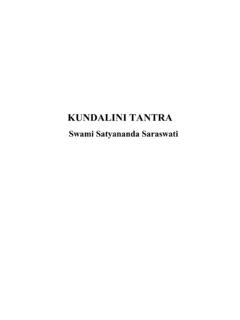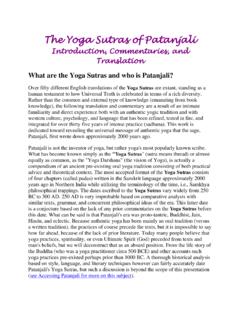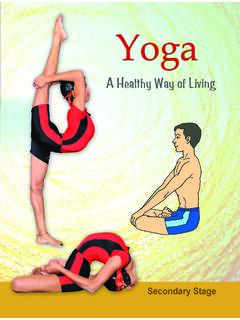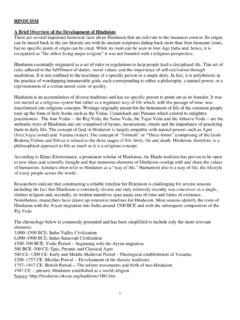Transcription of Yoga Therapy full book - DR.) SOHAN RAJ TATER
1 yoga Therapy . CONTENTS. Chapter 1 Role of yoga in total health 3-18. Chapter 2 Health management through yoga and naturopathy 19-34. Chapter 3 Utility of science of living in life building 35-46. Chapter 4 Common Yogic and naturopathic Prescription for healthy living 47-73. Chapter 5 Outcome of spirituality: vasudhaiv kutumbakam 74-76. Chapter 6 Formation of sacraments in girls: first through prekshdhyan yoga 77-90. Chapter 7 Concept of thought 91-95. Chapter 8 Physiological effects of asans and pranayam 96-104. Chapter 9 Role of yoga in coronary heart Disease 105-113. Chapter 10 Yogic Management of Diabetes 114-121. Chapter 11 Yogic management of hypertensive Patient 122-127. Chapter 12 Obesity, causes complications and Yogic 1. management 128-136. Chapter 13 The spiritual and scientific aspects of Suryanamaskar 137-147. Chapter 14 Special situation in modern life in relation to problems of infusing of Yogic practices in day to day life 148-156. Chapter 15 Importance of Yogic lifestyle for school children 157-163.
2 Chapter 16 Importance of yoga in the development of ideal life style: with special reference to university student 164-172. Chapter 17 Management of dietary fats for healthy living 173-179. Chapter 18 Effect of yoga -nidra on hypertensive patients 180-200. 2. Chapter-1. Role of yoga in total health What is yoga ? yoga is the science of life and the art of living. It is the common sense answer to overall physical and mental fitness. Basically yoga is a system of physical and mental self improvement and final liberation, that people have been using for thousands of years. yoga arose in the age of the Vedas and Upanishads. It is India's oldest scientific, perfect spiritual discipline. yoga is a method of training the mind and developing its power of subtle perceptions so that man may discover for himself the spiritual truths on which religion, beliefs and moral values finally rest. It is realization of our hidden powers. Swami Shivananda said, "He who radiates good, divine thoughts does immense good unto himself and to the world also".
3 yoga is science of life, it offers us simple, easy remedies and techniques and methods of health and hygiene to assure physical and mental fitness with a minimum of time, effort and expense. yoga in other term Preksha Dhyan invented by prominent Jainacharya Mahaprajna is such an uncomplicated, easy to learn technique of meditation. It comprised of the following . i. Kayotsarga (Total relaxation). ii. Antaryatra (Internal trip). iii. Svash preksha (Perception of breath). 3. iv. Sharir preksha (Perception of body). v. Chaitnya-kendra preksha (Perception of psychic centers). vi. Leshya dhyan (Perception of psychic spectrum). vii. Perception of the present moment viii. Perception of thoughts ix. Self-discipline x. Bhavna (counter-vibrations). xi. Anupreksha (contemplation). xii. Concentration. yoga is one of the most ancient metaphysical sciences, which investigates the nature of soul and, through its discipline, awakens the super-conscious mind of the man which unites the moral being with the immortal supreme spirit.
4 yoga leads to balance and also provides both a philosophy and a religion. The real joy of life appears when we can unify nature and culture, wealth and poverty, movement and stillness, attachment and detachment. yoga can serve both the individual and society. yoga is neither a sect nor an ideology but a practical training of mind and body. Broadly speaking, it has three main outcomes : it makes us more aware of our natural wisdom, it strengthens the body's ability to recover from illness or injury; it teaches us how to co-operate with others. yoga teaches us truth through mind and body rather than theory, it brings about deep change of attitude. The entire thrust of our life is to devote total attention to every action and, at the same time, to trust in the power of sacred. 4. Eight stages of Patanjal yoga are : i. Yama : The universal moral laws. ii. Niyama : Personal moral roots of conduct. iii. Asan : Yogic postures. iv. Pranayama : Acquiring and controlling prana or energy, by means of the breath.
5 V. Pratyahara : The withdrawl of the senses from the outer environment. vi. Dharana : Concentration. vii. Dhyana : Meditation. viii. Samadhi : Enlightenment. yoga is also a technique for achieving purest form of self- awareness, devoid of all thoughts and sensations. Today some kind of reconstruction of thought is necessary to understand clearly what the great yoga teachers of the past have taught. Patanjali, the systematiser of yoga , has explained the thoughts through Yogasutra. In the Gita and Upanishads we find a broader and positive expression of yoga . Our ancient masters through yoga teach us an art of living a life for eternally blissful experiences of even flow of happiness by removal of miseries and sufferings of our limited life. The term yoga means a systematic practice and implementation of mind and body in the living process of man to keep harmony with in self, within the society and with nature. 5. Kundalini yoga is a systematic and integrated practice for body and mind and its thrust to make a man creative.
6 By a new method, which is wholly safe, one can get the Kundalini power aroused in minutes. Hence this method is called the simplified Kundalini yoga , abbreviated to "SKY". Kayakalpa is the culmination of Kundalini yoga and its objective is to enable the practitioner to postpone the ageing process and death. In all sky centers in India, Malaysia, Singapore, South Korea, Japan and USA, Kayakalpa yoga is now being taught at regular intervals. These two yogic practices are very important in karma yoga , the world religion. What is total health Health is precisely, that condition in which human being has full sensitivity and in which all his faculties are operating fully. To actively work towards this condition is to cure illness and to develop maximum health. yoga is both a philosophy and a living religion, believes that the body is so important and trains it so strictly. Without health we can neither practice meditation nor attain enlightenment. For total health one should seek the truth by skepticism.
7 The body mind system possesses the innate power of recovering health and the yogic method of curing human ills, aims at stimulating it. Prominent health specialist Ben Jonson said, "O, health! health! the blessing of rich! the riches of the poor! who can buy thee at too dear a rate, since there is no enjoying the world without thee! . 6. Preksha (means to see inside with full concentration) may appear to mean different things to different people because it contributes to increase physical, nervous as well as spiritual energies. As per prominent Jainacharya Mahaprajna inventor of Preksha Dhyan yoga total health consists of physical, mental, emotional and spiritual health. i. On physical level, it helps each bodily cell to revitalize itself; it facilitates digestion, it makes inspiration more efficient and improves circulation and quality of blood. ii. On mental level it proves to be an applied method to train the mind to concentrate; it offers way to treat serious psychosomatic illness without drugs; it is an efficient tool for ending addictions and other bad habits; it reveals to one the mysteries of his mind by the realization and real experience of the inner consciousness which includes the subconscious and the unconscious.
8 Iii. On the emotional level, the strengthening of conscious reasoning controls reactions to environmental conditions, situations and behaviour of others; harmonization of the functioning of nervous and endocrine system, results in control and ultimate eradication of psychological distortions. iv. On spiritual level, regulation and transformation of blood- chemistry through proper synthesization of neuroendocrinal 7. secretions, dispassionate internal vibrations leads one to attain the power to control the mind and to become free from the effect of external forces compelling one to lose to equanimity. The following table shows the relation between endocrine glands and the Chaitnya-kendras : Endocrine glands Chaitnya-kendras Pineal Jyoti-kendra Pituitary Darshan-kendra Thyroids Vishudhi-kendra Thymus Anand-kendra Adrenals Taijas-kendra Gonads Swasthya-kendra and Shakti-kendra Constant triggering overreaction of the lower endocrine glands viz. adrenals and gonads result in pernicious habits, effecting our physical and mental health.
9 For good physical health Dr Dastur recommends: Sleep on a thin firm mattress with a wooden board underneath. Don't sleep on foam rubber mattress. Prolonged standing in one place puts great pressure on the spine, shift your weight from one foot to other to relieve the strain. Learn to relax when under stress. Do not lift a heavy load with straight knees from the floor. Bend your knees and lift it up. 8. Jainacharya Mahaprajna inventor of Preksha Dhyan yoga inspires for maintenance of total health: i. For maintenance of physical health one should always walk in morning fresh air and should observe Asans and Pranayama. ii. For maintenance of mental health one should get rid of worries and should deep dive in meditation and kayotsarga. iii. For achieving emotional health one should think positive and should always live in present and not in past or future. sound health and peaceful mind are a must for man to enjoy the material world and develop the consciousness to its perfection.
10 In order to achieve this purpose of birth one has to maintain harmony between body and life force, life force and mind, between individuals and society and between nature and will. Practicing appropriate exercises of body and mind and a virtuous way of living to maintain the harmonies described above constitute yoga . Thus karma yoga is a system of life utilizing the full potential of the body and mind with understanding and awareness for a happy, prosperous and peaceful life. All experiences in life are enjoyed only by the mind. Mind is the peripheral stage of consciousness. In the infinite state, the consciousness itself is the truth. As a man is endowed with the sixth sense which inherits the purpose of the realization of self, in time he should realize the self, which is consciousness. By 9. realizing consciousness man can live with satisfaction, harmony and peace. Realization of consciousness is the only one perfect and higher knowledge by which one can know everything in the universe.





